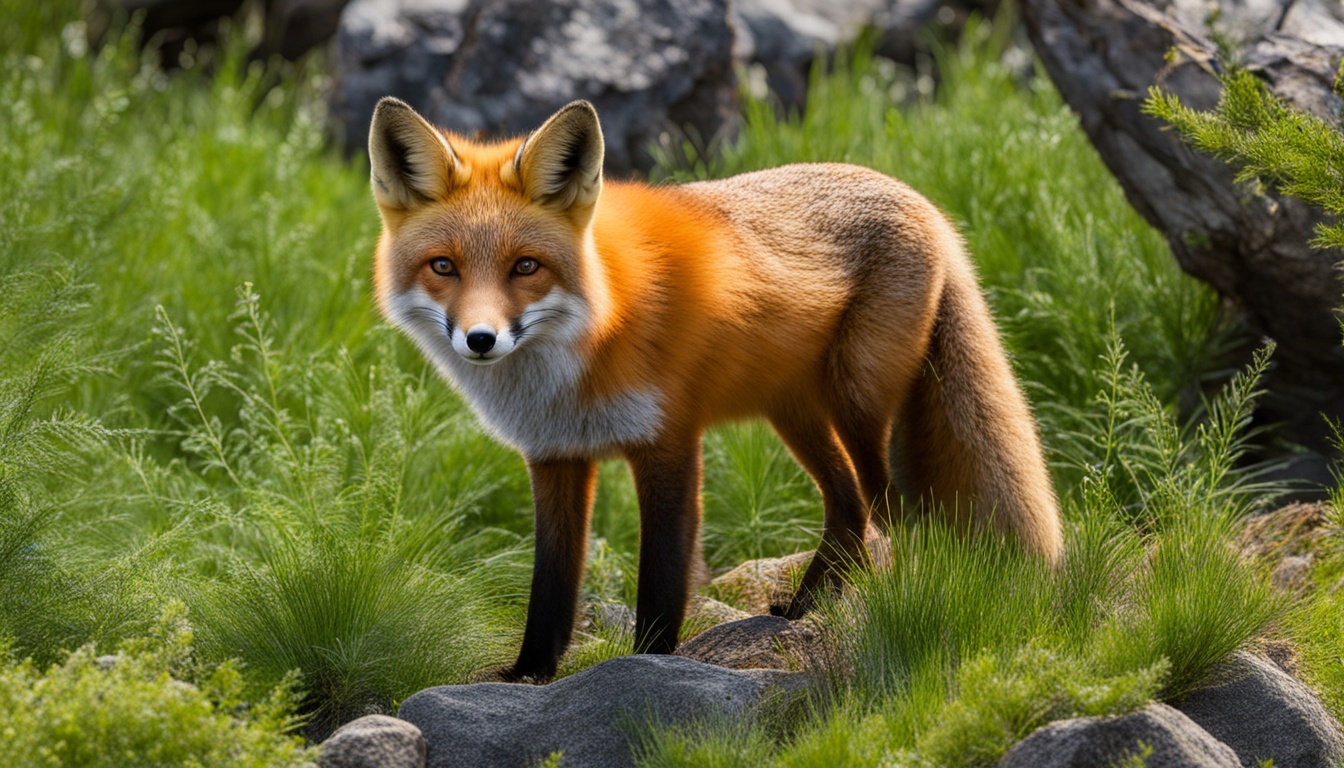In the USA, red foxes like a mix. They prefer places rich in different types of life. This includes woodlands, pastures, and the edges of marshes. This shows how they’re good at choosing their homes wisely. They usually stick to the same area for their whole lives.
These animals eat almost anything. Their diet includes fruits, small animals, and insects. Because they can eat different things, foxes can live almost anywhere. This is why they are found in many landscapes across the USA. Surprisingly, they’re even in big cities like Indianapolis. This shows how flexible and creative foxes can be with where they live. They’re able to live in many different places because of what they eat.
Overview of Fox Habitats in the USA
Fox habitats in the United States offer a wide range of places to live. They can be found in both forests and cities. This shows how adaptable they are. Foxes find places with food and privacy to survive.
In forests and woodlands, foxes have good hiding spots and enough prey to eat. Fox den locations in the United States are often found in these places. It’s where they raise their young because it’s safe and private. However, wetlands also play a big role. These areas have lots of food and safe spots for dens.
Even in cities, foxes manage to live. They can find food anywhere from small animals to garbage. They show great skill in adjusting to urban life. Yet, dangers like cars are a real threat.
Mountains are another habitat for foxes. They live in high places where weather changes quickly. There, they find various kinds of animals to eat. This shows their ability to survive in many places.
The fox is truly adaptable across the US. They find ways to live in different kinds of places. This includes natural areas and places where people live. Their ability to adjust lets them live in many habitats.
Forest Edges and Woodlands
Forest edge habitats and woodlands are very important for American foxes. They provide a mix of privacy and various plants that help foxes survive and hunt. These places are rich with different layers and lots of food, making them ideal for raising fox cubs.
Characteristics of Forest Habitats
Forest environments for foxes have a lot of plants that make it easy for them to hunt and find food. The thick bushes and trees help hide them from other animals. This environment also has plenty of good spots for foxes to live, like in fallen logs and hollow trees.
Why Foxes Thrive in Woodlands
In woodlands, American foxes do really well because of the food and places to hide. These areas are full of small animals and birds, which foxes love to eat. Also, the thick plants and up-and-down land make it the perfect place for them to surprise their food and catch it.
Examples of Forests in the USA
All over the United States, forests are amazing homes for foxes. Places like the woodlands in the Midwest and the mix of trees in the Appalachians are great examples. In Indiana, the woods are especially good for foxes, proving how these animals can use different forest resources. These areas keep foxes healthy by giving them lots of food and quiet places.
Urban and Suburban Areas
Urban foxes have expertly adapted to city and town life. The busy cities and quiet suburbs both have good and bad parts for these foxes. This shows how clever and flexible they are.
Adaptations of Foxes to Urban Environments
Urban foxes are good at using spaces created by humans. They find food in different places, like garbage and small pets. Places like parks and building sites give them good spots for hunting or living.
Benefits of Urban Areas for Foxes
Cities are full of food and not as many other foxes to compete with. This makes finding meals easier. Suburbs have lots of room and are quieter than the city, which is great for baby foxes.
Challenges Foxes Face in Cities
Living in the city can be tough for foxes. They are more likely to get sick and get hit by cars. Sometimes people try to hurt or catch them because they see them as a problem.
In the end, the success of foxes in our urban areas shows how well they can survive in many places.
Farmlands and Pastures
In the USA, foxes love farmland and pastures. They make the most out of wide open spaces. These areas have plenty of food and game animals that people introduced. So, it’s no surprise these spots are filled with foxes. Especially when they mix with woods and scrub areas.
Farm areas are great for foxes to live. They have lots of room to hunt. They can easily find small animals to eat. Plus, pastures are good places for foxes to have their babies. It’s a safe place for their young.
Even though these areas are open, there’s still places to hide. Scrub and woods provide cover. They also offer more food. Foxes are smart and can handle living near people very well.
Wetlands and Marshes
Wetlands and marshes are special spots for American foxes. They find lots to eat and shelter in these places. This helps the foxes keep the natural balance in the area. It’s important for their home’s health.
Ecological Role of Foxes in Wetland Areas
Foxes are key in wetlands because they eat rodents. This helps keep nature’s balance right by not letting some small animal populations grow too much. By hunting, they also keep the food chain going, adding to the area’s variety.
Examples of Wetland Regions in the USA
Places like Indiana have wetlands that foxes love. They have lots of food and places to hide. This is crucial for fox families. They can live and raise their young safely in these dense plant areas and around water.
Mountainous Regions
Foxes in mountainous areas face tough environments. They must deal with cold, steep land, and not much greenery. To survive, these foxes change how they hunt and their daily lives.
Challenges of Mountain Habitats
Foxes living high up are hit hard by the weather and land. It affects where they find food and shelter. They respond by becoming very skilled at surviving in these areas.
Altitude and Climate Factors
The higher up foxes live, the colder it gets. This changes how they act and keeps them on their toes. They use energy smartly and keep warm efficiently. The Appalachian woodlands, for instance, is home to such foxes.
Examples of Mountain Habitats in America
In the Rockies and Sierra Nevada, you find special habitats for foxes. Each area is unique:
- Appalachian Mountains: They have leafy forests, making it easier for foxes to hide and find food.
- Rocky Mountains: Foxes here face a mix of environments, like open meadows and thick woods.
- Sierra Nevada: Known for snow and rough mountains, it tests foxes’ ability to survive harsh winters.
In the end, American mountain foxes show us they can thrive in very challenging environments.
Desert and Arid Lands
Foxes are amazing animals that do well in tough places like deserts. Their secret? A varied diet. This diet helps them use what little is available very well. They eat small mammals, bugs, and even plants to survive.
What’s more, foxes in deserts know how to keep from getting dehydrated. They find water in their food and can go without drinking for a while. This shows how smart and adaptable they are, making the desert their home unlike many other animals.
Their fur is like a built-in coat for both hot and cold weather. This and their smart hunting skills prove they are pros at living in arid places. They survive and even do great in the desert, thanks to their skills and hardiness.
| Key Adaptations | Description |
|---|---|
| Varied Diet | Omnivorous diet allows utilization of limited food sources. |
| Water Conservation | Obtains moisture from prey and tolerates low water availability. |
| Physical Adaptations | Thick fur for temperature regulation, efficient foraging habits. |
What types of habitats do foxes prefer in the USA?
Foxes in the United States pick their homes based on what’s around, especially food and quiet places to raise young. It’s key to know their favorite spots for saving their habitats and planning cities better.
Preferred Habitats Based on Food Availability
Foxes love places where they can find lots of different foods. They eat everything from fruit to small animals and bugs. This is why they do well in areas that mix forests with farms. Cities are also good for them because they can eat our leftovers. This is why you might see more foxes in towns.
Breeding Site Preferences
Foxes need quiet and safe spots to raise their young. They choose places like forests, scrublands, and the hidden parts of farms. Here, they can find spots to rest that are safe from other animals. In cities, they might use places like under sheds for their babies. This shows how smart and able they are to live in different places.
Coastal and Dune Habitats
Foxes living in coastal areas change a lot with the seasons. They depend on the unique dune ecosystems for food and shelter all year. These areas are key to the foxes’ survival.

Seasonal Use of Coastal Areas
In seasons with more seabirds, foxes have plenty to eat. This abundance of food helps them survive and raise their young. It’s a strategy that works well for their health and numbers.
Examples of Fox Dens in Coastal Regions
Fox dens are common in coastal places, showing these animals are adaptable. Dunes offer a perfect spot for breeding and keeping fox pups safe. It protects them from other animals looking for an easy meal.
| Coastal Region | Fox Den Characteristics | Seasonal Activity |
|---|---|---|
| Pacific Coast | Sandy burrows near seabird colonies | High activity during spring and summer |
| Atlantic Coast | Dense vegetation around dunes | Peak usage in late summer and early fall |
| Gulf Coast | Hidden dens within coastal scrub | Increased presence in winter |
Mixed Scrublands and Brush Areas
In mixed scrublands, American foxes find the perfect home. There’s a great mix of plants and land here. This makes it easy for scrubland foxes to find food and hide well. They can eat many things and hunt efficiently because of the different plants. Having lots of plants means they can find the perfect spot to build a den, where they can be safe and hidden.
Foxes in these areas can eat small animals, birds, fruits, and even insects. They are very good at living in places with a lot of variation. This includes places with many different types of plants. The rich ecosystem in these zones is not only good for finding food and shelter. It also helps keep the fox population healthy and strong.
Here are the reasons why scrublands and brush areas are good for foxes:
| Feature | Benefits for Foxes |
|---|---|
| Dense Vegetation | Offers ample cover and seclusion for hunting and denning |
| Diverse Plant Life | Supports a varied diet, providing numerous foraging opportunities |
| Open Clearings | Facilitates efficient movement and hunting |
| Rich Ecosystem | Enhances overall health and sustainability of the fox population |
Foxes in these zones are incredibly resourceful. They know how to use the good parts of their home. But they can also deal with the tough parts. This ability makes them successful in many different places.
Conclusion: Fox Habitat Diversity in the USA
Across the United States, there are many different landscapes where foxes live. You can find foxes in dense woodlands and quiet forests of the Midwest. They also roam the huge deserts of the Southwest. Foxes truly show they can live anywhere. They’re even found in places where people have changed the land a lot.
Foxes are good at finding food in many places. They live in farms, by the coast, and in sandy areas. This ability to live in different locations helps them find food and have babies. They really know how to survive in the wild.
Foxes have learned to live in all kinds of habitats in the USA. Their ability to fit in well with different places is amazing. They can be in cities, farms, and tough areas. They keep adapting to the changing world around them.










